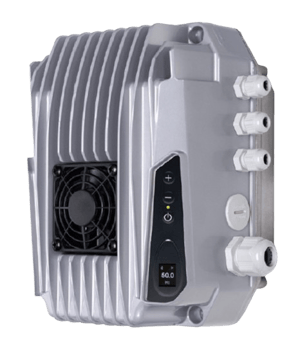The MIDA Inverters are engineered specifically for pump applications, offering energy savings through variable speed control, soft start, and soft stop features. These inverters enhance system longevity and reliability while being suitable for installation in humid or dusty environments, thanks to their IP66 rating.
Installation is simplified, whether mounted on the motor or wall, and commissioning is quick and easy with the initial configuration wizard. The robust aluminium casing and independent ventilation ensure exceptional thermal and mechanical performance. The inverters are controlled by a 4-20mA transducer and are available in stainless steel or PDVF options.


THE CREST PUMPS LIFETIME GUARANTEE
No matter how old your pump becomes, in the unlikely scenario that you have a problem, our engineers will be on hand to diagnose the issue and help you get up and running again.That’s why, with Crest Pumps you’ll never need to worry about unplanned downtime again.
Talk to us now to discuss your chemical pump requirements or book a free site audit to see how much time and money you could save!
Built to outlast and outperform
Discover the significant savings you can achieve and explore the potential financial benefits that await you.

Technical Specification
| Model | Vin + 15% VAC | Max V out VAC | Max I In A | Max I Out A | P2 Motor Power *kW |
Size |
| MIDA 203 | 1 x 230 | 3 x Vin | 4,5 | 3 | 0,55 | 1 |
| MIDA 205 | 1 x 230 | 3 x Vin | 7.5 | 5 | 1.1 | 1 |
| MIDA 207 | 1 x 230 | 3 x Vin | 11 | 7.5 | 1.5 | 1 |
| MIDA 304 | 3 x 230 | 3 x Vin | 3,7 | 4 | 0,75 | 1 |
| MIDA 306 | 3 x 230 | 3x Vin | 5,4 | 6 | 1.1 | 1 |
| MIDA 309 | 3 x 230 | 3x Vin | 8 | 9 | 2.2 | 1 |
| MIDA 314 | 3 x 230 | 3 x Vin | 13,5 | 14 | 3 | 2 |
| MIDA 318 | 3 x 230 | 3x Vin | 17.5 | 18 | 4 | 2 |
| MIDA 325 | 3 x 230 | 3x Vin | 24 | 25 | 5.5 | 2 |
| MIDA 330 | 3 x 230 | 3x Vin | 29 | 30 | 7.5 | 2 |
| MIDA 338 | 3 x 230 | 3x Vin | 36,5 | 38 | 9.3 | 2 |
| MIDA 344 | 3 x 230 | 3x Vin | 42 | 44 | 11 | 2 |
| MIDA 404 | 3 x 380 - 460 | 3x Vin | 3,7 | 4 | 1.1 | 2 |
| MIDA 406 | 3 x 380 - 460 | 3x Vin | 5.4 | 6 | 2.2 | 1 |
| MIDA 409 | 3 x 380 - 460 | 3x Vin | 8 | 9 | 4 | 1 |
| MIDA 414 | 3 x 380 - 460 | 3x Vin | 13.5 | 14 | 5.5 | 2 |
| MIDA 418 | 3 x 380 - 460 | 3x Vin | 17.5 | 18 | 7.5 | 2 |
| MIDA 425 | 3 x 380 - 460 | 3x Vin | 24 | 25 | 11 | 2 |
| MIDA 430 | 3 x 380 - 460 | 3x Vin | 29 | 30 | 15 | 2 |
| MIDA 438 | 3 x 380 - 460 | 3x Vin | 36.5 | 38 | 18.5 | 2 |
| MIDA 444 | 3 x 380 - 460 | 3x Vin | 42 | 44 | 22 | 2 |
Frequently Asked Questions
A Variable Speed Drive (VSD) inverter, also known as a Variable Frequency Drive (VFD), is a device that controls the speed and torque of an electric motor by varying the frequency and voltage of the power supplied to it.
In pump applications, a VSD inverter allows the motor to operate at different speeds depending on demand, rather than running at a constant speed. This helps to optimize energy consumption, reduce wear and tear on pump components, and improve process control. For example, instead of using throttling valves to control flow, a VSD can adjust the motor speed to match system requirements, leading to significant energy savings, particularly in applications with variable flow demands.
VSDs are commonly used in HVAC systems, water treatment plants, industrial pumping, and chemical processing, where precise flow and pressure control are essential. Additionally, they help reduce issues like water hammer, overheating, and mechanical stress, ultimately extending the lifespan of both the pump and the motor.
The SI system (International System, or System International in French) is the standard system of measurement used globally for scientific, industrial, and everyday purposes. It is based on the metric system and provides a consistent and coherent set of units for measuring various physical quantities such as length, mass, time, temperature, and more.
The SI system is built on seven base units, each representing a fundamental physical quantity. These base units are:
Meter (m) for measuring length
Kilogram (kg) for measuring mass
Second (s) for measuring time
Ampere (A) for measuring electric current
Kelvin (K) for measuring the temperature of a substance
Candela (cd) for measuring luminous intensity.
Best Efficiency Point (BEP) is the operating point at which a pump runs at its highest efficiency while minimizing energy consumption and wear. It
represents the optimal balance between flow rate and head, ensuring the pump delivers the best performance with the least amount of stress on its components.
Operating a pump away from its BEP—either too far to the left (low flow, high head) or too far to the right (high flow, low head)—can lead to problems such as cavitation, excessive vibration, increased energy costs, and premature wear on bearings and seals. Proper pump selection and system design aim to keep the pump as close to its BEP as possible to maximize efficiency, reduce maintenance costs, and extend pump life.
Lifecycle Cost (LCC) Analysis is a method used to determine the total cost of ownership of a pump over its entire operational lifespan. Instead of focusing solely on the initial purchase price, LCC considers all costs associated with the pump, including installation, energy consumption, maintenance, repairs, downtime, and disposal or replacement. By evaluating these factors, businesses can make informed decisions that minimize overall expenses and improve efficiency.
For pumps, energy costs typically make up the largest portion of LCC, often exceeding the initial purchase price. Other significant factors include maintenance and repair costs, which can increase if a pump operates outside its Best Efficiency Point (BEP) or is not properly maintained. By selecting energy-efficient models, implementing predictive maintenance, and considering materials that extend pump life, businesses can reduce LCC and achieve long-term cost savings while improving reliability and performance.
NPSHa stands for Nett Positive Suction AVAILABLE and NPSHr stands for Nett Positive Suction Head REQUIRED.
Now, what is the difference between NPSHa and NPSHr? Well, firstly NPSH is a measure of the pressure experienced by the fluid at the suction of the pump. This is always quoted in metres (or feet) rather than as a pressure because head is a fluid independent property. Keep in mind that a pump will always lift liquid to the same height regardless of the fluid's respective densities.
NPSHa (available) is a property of the system and is calculated by the system designer giving a value of the pressure on the suction side of the pump.
NPSHr (required) is a property of the pump. This is calculated by the manufacturer as the point where cavitation occurs. It is good practice to have a safety margin between 0.5m and 1m.
Trusted By The Best





































